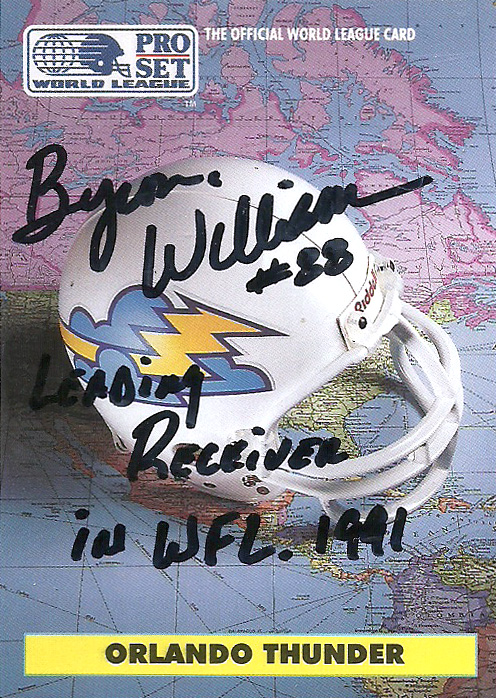
COACH: Don Matthews (1991), Galen Hall (1992)
STADIUM: Citrus Stadium
RECORD: (1991) 5-5, (1992) 8-2
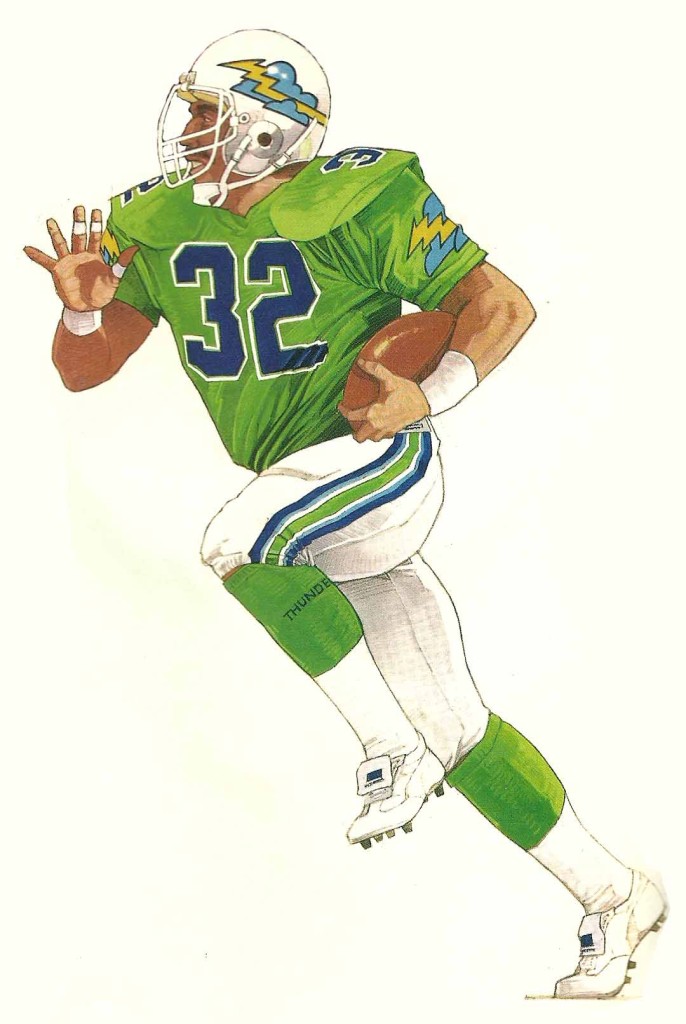
BACKGROUND:
Orlando was the second team in the United States awarded a WLAF franchise during March of 1990. The Orlando Thunder’s majority owner was Raj Bhathal, a Newport Beach swimwear magnate. Originally unable to purchase the rights to the Surge or the Riders, Bhathal bought the majority stake in the Orlando franchise after visiting the city for just a single day. He preferred to let Dick Beam, a former Rams executive run the front office, while Lee Corso- of College Football Gameday fame, was the General Manager.
Corso lured away legendary coach Don Matthews from the CFL in 1991, to coach the team. The Orlando Thunder initially employed a no-huddle offense that primarily showed up in a Run ‘N Shoot variant that Don’s offensive coordinator, Galen Hall cooked up. Hall was also instrumental in bringing in QB Kerwin Bell- who he used to coach at Florida. Another notable coach was former Charger wide receiver Wes Chandler, who would get his pro break coaching with the team.
The Thunder name was selected out very quickly during the origination process- and there were 6 different designs that the team felt comfortable moving forward with. Wilson- the manufacturer of most football equipment jerseys at the time- did not have a fluorescent lime green in their fabric selection and had to make a concession in order to get it done.
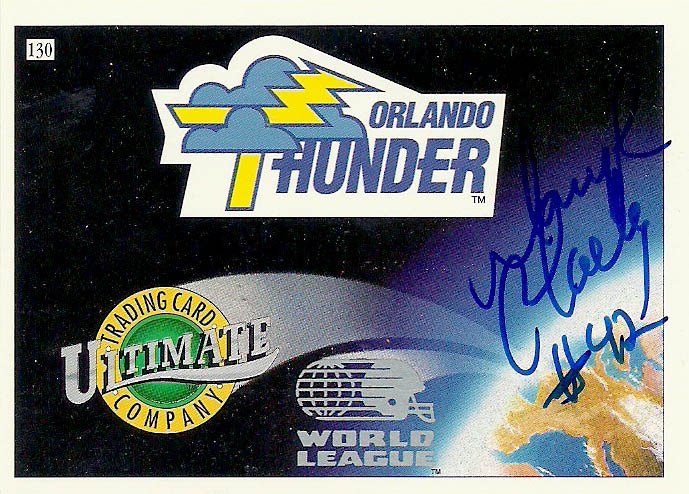
1991:
Their first game would be against the San Antonio Riders in a stunning offensive contest on a Monday Night USA Network telecast. The Thunder won 35-34, led by quarterback Kerwin Bell wearing the state-of-the-art helmet camera. He’d throw 3 bombs to future league leading receiver Byron Williams. (Williams finished with 11 touchdowns receiving that season, leading the league.)
At runningback the team would rely on Myron Jones, -but Eric Mitchel (a Barry Sanders backup at Oklahoma) sparked the Thunder later on in the season. He’d finish second on the team in receptions and have a whopping 6.7 yards per carry. Carl Painter, another NFL vet, was the league leader in kick off returns with 597 yards and a 24.9 yard average. On defense Winfred Bryant (6 sacks) and Wayne Dickson (5 sacks) paced the team lead. In the secondary underrated Mike Nettles made 3 picks and 4 sacks. Safety Billy Owens also contributed 3 sacks and turned in an interception from the defensive backfield. Errol Tucker chipped in 2 interceptions, and led the WLAF in with an improbable 20.7 punt return average, taking one of them back for a touchdown.
In week 2, the Thunder tacked up 58 points on the Skyhawks giving them a two week total of 93 points- one of the highest combined two week totals for the opening of a football team’s season in sports history. -The problem is that the Thunder happened to give up as much yards and points as they scored.
After their first two victories, the Thunder dropped 5 straight, drubbed in 4 straight games, 35-12, 33-13, 31-6 and finally 42-6 to the New York New Jersey Knights. After a 17-14 loss to the Galaxy, the Thunder would rebound, winning their final 3 contests, to finish 5-5 for 1991. It was an uneven ending for the Thunder that season with extreme highs- and lows.
After the season, Beam cleaned house, from top to bottom. The team attempted to lure a variety of names to the open head coaching position including: David Shula, Tom Walsh, Mike Gottfried, and Dick Coury but were unable to land any of them. In the end, the Thunder promoted offensive coordinator Galen Hall to head coach for the 1992 season.
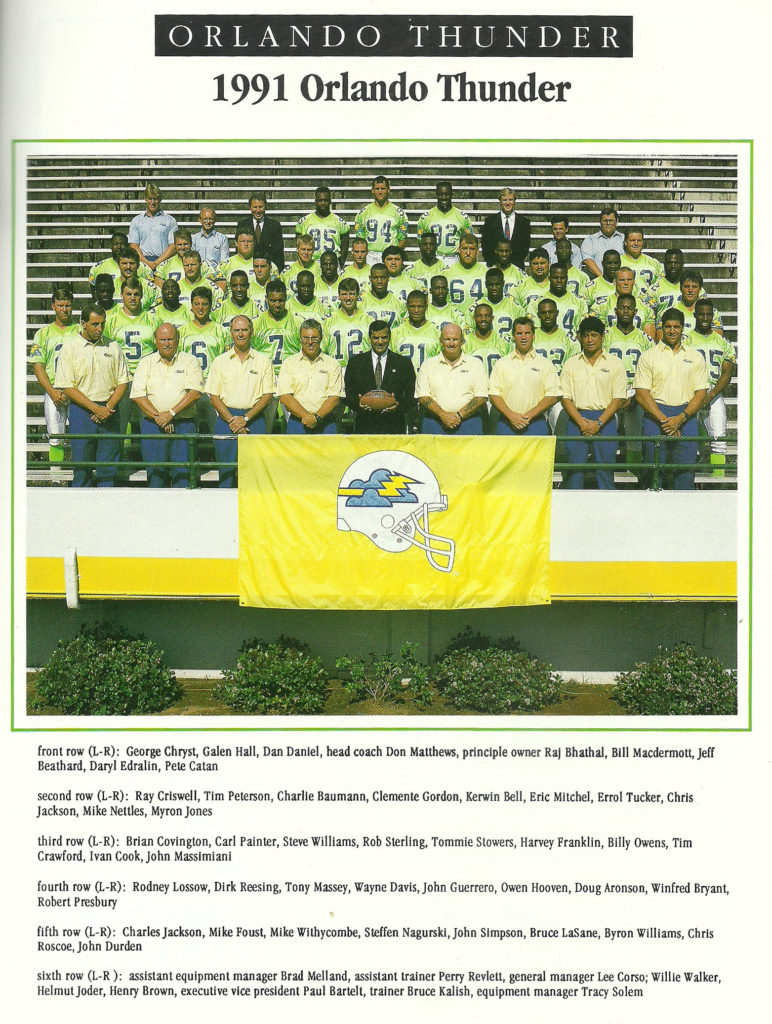
1992:
Hall continued to employ the spread offense but also incorporated a fullback and tight end more into the offense. Although Kerwin Bell was serviceable in 1991, the team seized at the opportunity to snag Scott Mitchell (allocated from the Dolphins) and started him over Bell at quarterback.
At runningback the team brought in Darryl Clack (former Dallas Cowboy), and former 1st round fullback, Texas A&M product, and New York Jet, Roger Vick. League leading Byron Williams was be traded in the middle of the night to the New York-New Jersey Knights partially over a contract dispute and him playing in the CFL. In his place the team would employ Joe Howard Johnson and Kansas City Chiefs receiver Willie Davis.
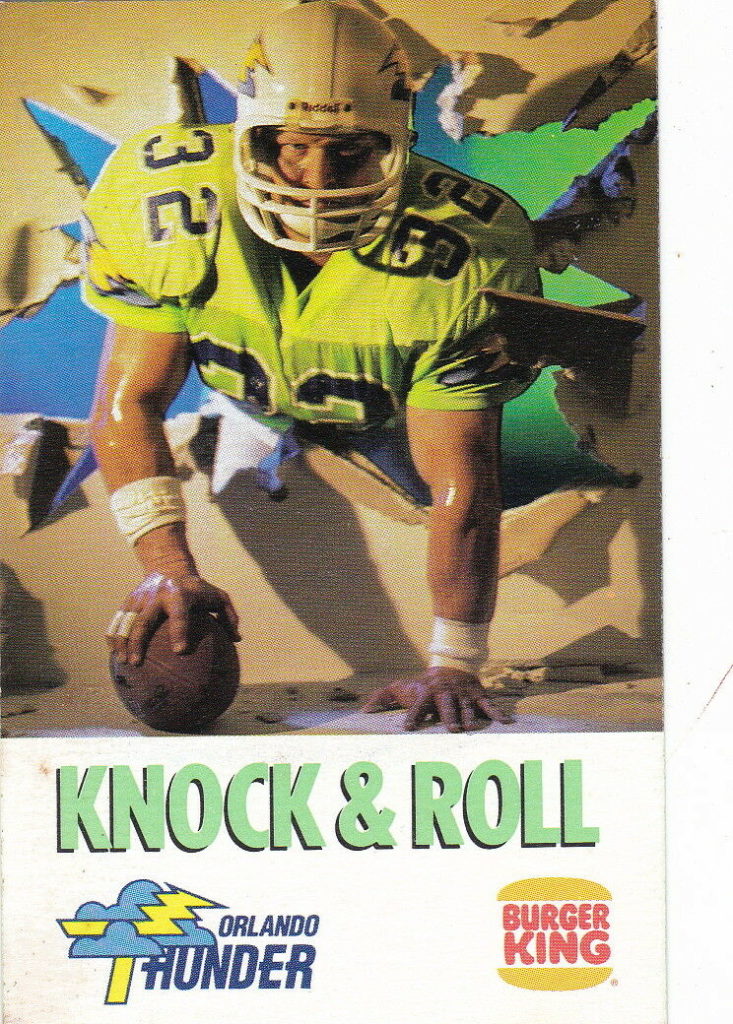
In the team’s 4-3 defense, the Thunder added on the defensive line Karl Dunbar (future defensive line coach mastermind), and future radio personality Dan Sileo. Tracy Rocker was drafted with the team’s first overall pick, but he’d be injured and cut during training camp. Linebacker saw the return of Wayne Dickson, while in the secondary most of the team would be replaced, with Rogers and Nettles returning from the 1991 squad.
Malcolm Floyd would make his debut with the Orlando Thunder, but made his mark later in the CFL.
The Thunder improved their defense, and cured their consistency woes of 1991. They came into San Antonio and beat the Riders handily in 1992, en route to an 8-2 record, tying for the league best with Sacramento. They’d cruise into the playoffs and play in World Bowl II versus the Sacramento Surge, narrowly losing to them 21-17.
Scott Mitchell finished as the second leading passer in the league, while Clack at runningback would finish 3rd in rushing with Vick at 5th. At wide receiver Johnson finished 3rd in receptions with 56 catches and received All- World League honors, along with tackle Rick Cunningham, Darryl Clack, cornerback Glenn Rogers, and kicker Tracy Bennett.
Galen Hall was named Coach of the Year after the season as well, but all would be for not, as the WLAF reorganized- and the Thunder- would not be heard of again.
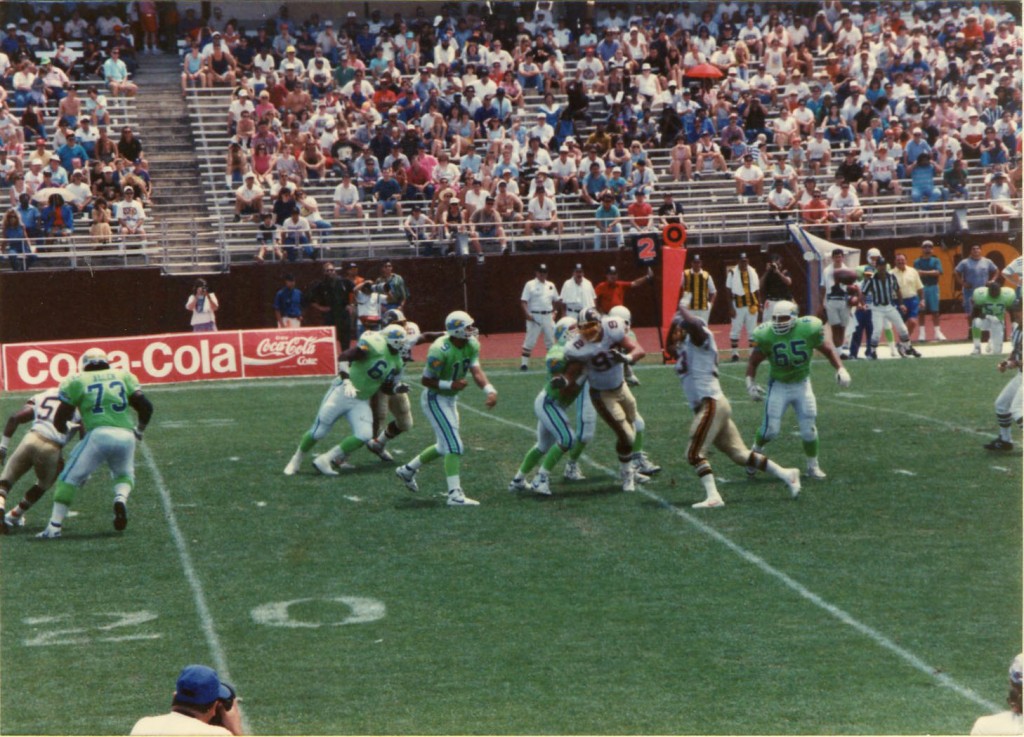
NOTES:
The Thunder are probably most fondly remembered for those fluorescent green uniforms, and were recently voted #2 on the worst uniform list of all-time on ESPN.
Training camps and the league’s inaugural draft were held in Orlando.
Technically, the Thunder were the only franchise in the league to switch over head coaches between 1991 and 1992, going from Don Matthews, who fled back to the CFL, to Galen Hall.
The Thunder played in cavernous Citrus Stadium but were unable average over 20,000 fans in either season. Despite the team’s 8-2 record, the Thunder had the smallest season ticket holder base in 1992 with less than 5,000 people. This also had put financial duress on Raj Bhathal, and it had been rumored that he was attempting to sell the franchise- or the league had been attempting to force his hand to do so.
Walkup tickets were affordable to boot running between the 30 yard line at $19.50, 25 yard line to goal line at $15.50, and general admission- endzones at just $8.50.
Many years later the Thunder name would be reappropriated by the NFLE to be used as the name for the Berlin Thunder. Thankfully they wouldn’t utilize the same color scheme or logo.
LEGACY:
Orlando has had four professional franchises since the departure of the Thunder. The Arena Football Predators were the most successful of the teams to take on the Orlando market. Traded publicly at one point, the franchise played in the city from 1991 to 2016- before folding due to disagreements with the league.
The Orlando Rage, coached by Galen Hall (XFL) lasted just one season in 2001. The team was heavy favorites to win the championship but was upset in the playoffs by the San Fransisco Demons. – The XFL folded after the season.
Orlando then had to wait until 2009 to receive a new football franchise, when the UFL awarded the Florida Tuskers to the city. Despite the best intents of the league however, Orlando was unable to support the Tuskers either, and after the 2010 season the team was shuttered to Virginia.
Again it appeared that Orlando was on the upswing in 2018. They’d be named as the founding franchise of the Alliance of American Football with Steve Spurrier as their head coach (Apollos). The team zoomed out to a 7-1 record before that league- was shuddered as well.
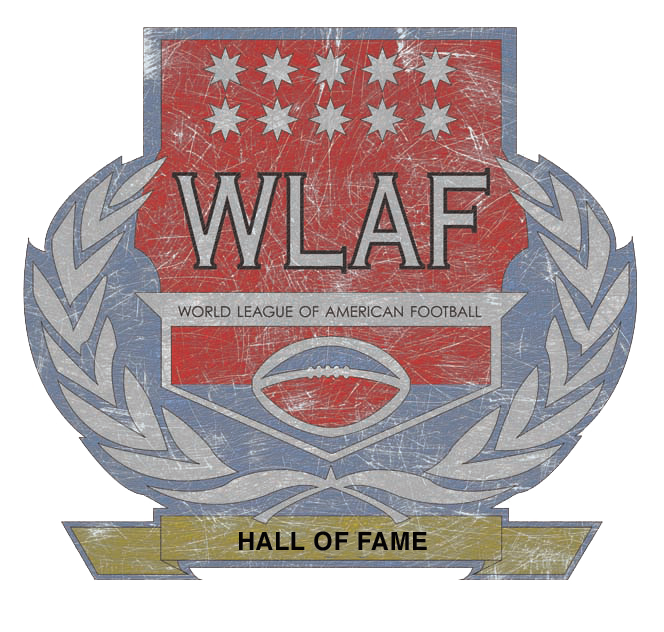
HC- Don Matthews, Galen Hall
Front Office: Lee Corso
QB- Kerwin Bell, Scott Mitchell
RB- Darryl Clack, Eric Mitchel, Myron Jones, Grantis Bell, Roger Vick, Carl Painter
WR- Byron Williams, Bruce Lasane, Stacey Simmons, Willie Davis
TE- Michael Titley
OL- Rodney Lossow
K- Charlie Baumann
DL- Karl Dunbar, Tracy Rocker
LB- Dean Witkowski, Wayne Davis, Wayne Dickson
DB- Erroll Tucker, Rob Sterling, Todd Krumm, Glenn Rogers, Malcolm Frank
At this time I am still missing autographs on these cards from:

ProSet 1991 WLAF:
John Guerrero
Billy Owens
Mike Withycombe
Wild Card WLAF 1992:
Joe Howard-Johnson
Rocen Keeton
Ultimate WLAF 1992:
Billy Owens
Chris Roscoe (DEC ?)
Tommy Stowers
CUSTOM:
Dan Sileo